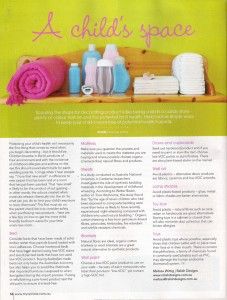
A CHILDS SPACE (unedited)
by Melissa Wittig.
The excitement of creating and decorating a child’s bedroom is one of the joys of parenthood. As parents we try to create a bedroom space for our children that is magical, fun, stimulating yet restful, safe and comforting. A room they can grow in and a room that can grow with them over time.
With the plethora of decor product choice on the market it is easy to become overwhelmed with the options. The experience of shopping for decorating product can be likened to the experience of being a kid in a candy store, plenty of colour, texture and the potential for ill health.
With the dazzle of sparkles and the many colours of so called “fantastic plastic” it’s no wonder many parents are distracted from the innate will to protect their child’s health.
A child’s bedroom is a space where our children spend a significant amount of time, whether for play or sleep. This space and the things that fill the room have the potential to impact on their life. Just like the shape sorter in the toy box can impact on the child’s spatial and co-ordination development, the carpet on the floor can impact on a child’s health.
Childhood allergies and asthma rates for children are constantly rising, both these conditions rely on the respiratory system, involving breath and lungs. Children breathe in the bi products of their environment. I have often heard people saying “I love that new smell”, when their new carpet is laid or a room is freshly painted. That new smell is actually a gift from your nose to your body telling you to open the nearest windows and doors until the odour is gone. The “new smell” is likely to be the product of out gassing, the materials releasing chemicals into the air, which will eventually over time dissipate. The toxic materials that children’s products are made from are worrying and should be a national health concern. A child doesn’t have to eat their bedroom furniture for it to get into their body. What is in the child’s air will get into their body through breath and the use of their lungs.
When preparing to go shopping for a bedroom scheme there is so much more to consider than colour and bedroom style. As noted above parents consider safety a priority for a child’s room but the health of a room is often forgotten, it is certainly not promoted or governed to the extent required. Children do not have fully developed immune, reproductive or nervous systems. A baby or child’s liver and kidneys are not as effective at flushing harmful substances from their bodies. When exposed to air pollution children are more likely than adults to suffer bronchitis, pneumonia, ear infections and asthma.
A shopping list for decorating a child’s bedroom scheme may include:
- First bed
- Mattress
- Sheets
- Blanket
- Paint for the walls
- Draws / cupboards
- Wall art
- Lamp
- Toy box
- Toys
- Night light
There is so much you could learn about the following, however a few tips on each of these will get you started to creating a healthy bedroom for your children.
Bed
Consider beds that have been made of solid timber rather than particle boards loaded with toxic adhesives. Choose hardwood beds that have been stained using low VOC stains. Avoid painted beds that have not used low VOC product. Buying Australian made beds not only helps the Australian economy but you will also avoid the chemicals that imported furniture is exposed to when fumigated during the import process. If using or refurbishing a pre loved product, test the old paint to ensure it is lead free paint.
Mattresses
Polyurethane Foam which can be found in some mattresses is made from a variety of chemicals; three of the main ingredients are crude oil, natural gas and sodium chloride. Flexible polyurethane foam combines chemicals known as isocyantes and polyols with other chemicals such as colourants and fire retardants. These chemicals have safety data sheets associating them with environmental and human health hazards. Yet when mixed together to create a product that we sleep on or sit with health warnings are not evident on labels. There are many types of mattresses on the market, question the process and materials used to create the mattress. Fire retardants used on bedding is another contentious health issue. Where possible choose organic (chemical free) natural fibres and product.
Sheeting
In a study conducted at Australia National University in Canberra researchers investigated the role of synthetic bedding materials in the development of childhood wheezing. According to Walter Bader, Author of Toxic Bedrooms, a result of this study was: “ldren who had been exposed to composite bedding were more than twice as likely to have recently experienced night wheezing compared with children who used natural bedding. The results of the study showed that bedding exposures in infancy are prospectively associated with the development of childhood wheezing.”
Organic cotton sheeting is an option free from petroleum based fibres, pesticides, herbicides, fire retardant and wrinkle resistant chemicals.
Blankets
Natural fibres are great, organic cotton blankets or wool blankets are a great natural alternative to synthetic products.
Paint for the Walls
Choose a low VOC paint product to use on your walls. However, be wary of paint companies who label their tins “low VOC”, yet the tint (colour) which they add to the tin may be high in VOC’s which means you are not getting the clean air you thought you were paying for.
Draws and Cupboards
Follow the same journey as for the bed purchase – seek out hardwood product and if you need to paint or stain the item choose low VOC paints or stain finishes. There are plant based stains on the market. Remember that healthy alternatives do exist unfortunately many of the companies developing healthier alternatives do not have the marketing dollars to splash their product in the media so it may take a little extra effort to find, but your child’s health is worth it.
Wall Art
Avoid plastics, alternative decor products are fabrics, ceramics, low VOC artworks.
Lamp shades
Avoid plastic based products, glass, metal or fabric shades are better alternatives.
Toy box
Plastic boxes are cheap, easy to obtain and come in great colours, but plastics are off gassing offenders. Avoid plastic, natural fibres such as cane, rattan or hardwoods are great alternatives. Storing toys in a cabinet or closed chest will also assist with minimising dust collection that can hinder allergies.
Toys
Avoiding plastic toys is ideal, however telling your child they can’t have the latest wish list toy is a tough ask, with many made from plastics. It would be wise to avoid plastic toys where possible, especially those that children bathe with, place near their face or in their mouth.
There is concern that phthalates, a family of chemicals found in commonly used plastics such as PVC that are used to make plastic flexible may damage the human endocrine (hormonal) system. In the report “Our Stolen Future”, The World Health Organisation and the US National Institute of Environmental Health Sciences conclude that evidence from animal and human studies justifies concerns about possible health impacts on humans by endocrine disrupting chemicals.
Night Light
Melatonin is a powerful protective substance the body produces at night in darkness. Light at night hinders the body’s production of melatonin. In 2005 Cancer Research drew links between decreased melatonin levels and breast cancer. As we wait for science to further investigate it may be prudent to encourage children to sleep in the dark and keep light after dark to a minimum so their bodies can maximise producing this protective substance.
Add a Plant to the Room
In 1980 NASA’s John Stennis Space Center discovered that household plants could remove VOCs from sealed test chambers. Further studies have since been undertaken and the ability of plants to improve the quality of air we breathe is now accepted and promoted within corporate commercial building developments through initiatives such as Green Star. Indoor plants assist with removing indoor air pollutants, a great reason to bring nature indoors. If placing a plant in a small child’s room this will need to be placed on an unattainable shelf to avoid children playing with or eating the dirt. Plant species have varying abilities to remove different pollutants ask your local nursery for guidance or send me an email for further information.
If you consider the above you can feel very satisfied that you are contributing not only to the health of your child but also to your homes indoor health for the benefit of the whole family.








 Register Your Product
Register Your Product